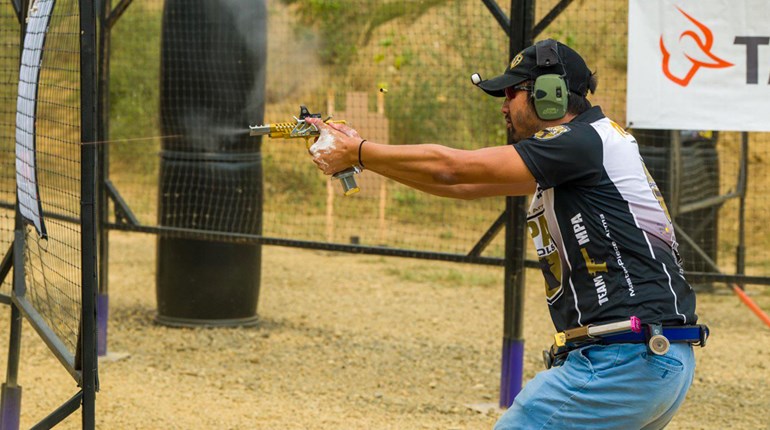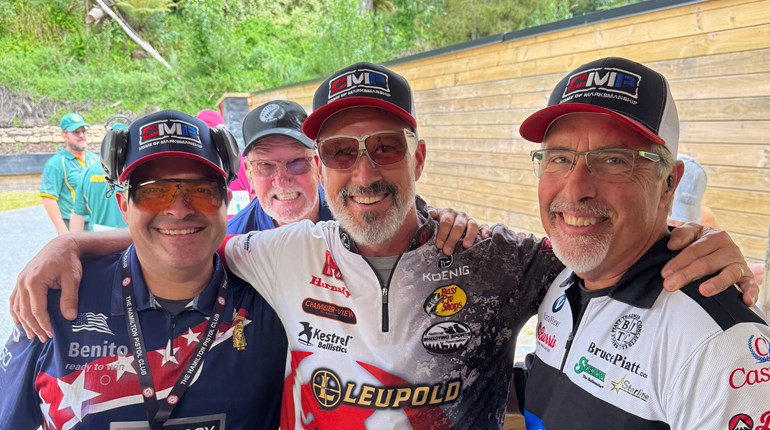
Although the use of optical reflex sights is expanding in USPSA, there are still an overwhelming number of competitors who want to see some “iron on the target” and opt for traditional iron-sighted handguns. Participation in these handgun divisions is strong, and here’s a look at what competitors brought to the 2018 USPSA National Championship.
Limited and Limited 10 (L10)
The equipment rules for these divisions are rather generous. Guns are not allowed to have compensators, ported barrels or optical sights. But beyond that, SA/DA, striker-fired, and single-action guns are allowed. There are few non-standard restrictions on holster and magazine carrier positions on the belt.
The divisions are scored Major (165 PF) and Minor (125 PF). The minimum caliber for Minor is 9mm and the minimum calibers for Major are .357 SIG and .40 S&W. Magazine length is restricted to 141.25mm, except for those shooting single stack guns, which may use 171.25mm magazines. The difference between Limited and L10 is that L10 was created to allow Limited guns to be shot in those states with a 10-round magazine capacity limit. L10 division guns may only load 10 rounds into a magazine. Beyond that, they are essentially the same guns.
This was the most popular division at the 2018 Championship with 281 shooters in Limited and 37 in L10. Of those, 34 percent were shooting their first Nationals.

The most popular gun manufacturer was STI, with 39 percent choosing it. SV Infinity followed at 10 percent, with Phoenix Trinity (9 percent), CZ-USA (7 percent), Glock (6 percent), Tanfogolio/EAA (3 percent) and Springfield Armory at 2 percent.

Extending the magazine length to legal limits often involves aftermarket extended base pads and MBX led that field at 28 percent, while Dawson followed at 24 percent, Taran Tactical at 17 percent and Springer Precision at 11 percent.
Given the slight capacity advantage experienced by the 9mm, and the fact that A-Zone hits count the same for Major and Minor, some might think Minor might be popular. But only 12 percent of the shooters chose 9mm, while 87 percent stayed with the Major .40 S&W. Only 1 percent chose the .45 ACP, and they were very likely L10 shooters. Handloaded ammunition was used by 75 percent of the shooters, with 48 percent choosing coated bullets, 36 percent jacketed, 15 percent plated, and 1 percent cast. The most popular bullet weights were 180 grain (64 percent) which easily makes Major in a .40 S&W. Next was 200 grain at 13 percent, 205 at 9 percent, and 165- and 147-grain loads at 3 percent.
Of the 25 percent shooting factory ammo, 14 percent of them chose Federal. Precision Delta was next at 6 percent, with Atlanta Arms and T1 ammo chosen by 2 percent.
Single Stack
This division was created to provide a home for John Browning’s classic 1911 semi-automatic. Guns allowed in this division must be metal-frame 1911-type pistols that are available for purchase by the general public. Like Limited/L10, compensators, porting, and optical sights are not allowed. It is also scored Major and Minor. As with Limited/L10 the minimum calibers for Major are .357 SIG and .40 S&W, with 9mm being minimum for Minor. And like Limited, different magazine capacities apply to each. In this instance that difference could be significant.
Major caliber guns allow only eight rounds in the magazine, while Minor caliber guns can have 10 rounds. That may seem like a small difference, but given the target layouts in USPSA it can be an important one. A Zone hits count the same for Major and Minor, but the additional two rounds in Minor allow for greater latitude in make-up shots, as well as where and when one has to reload during the Course of Fire. Although target scoring favors Major, some shooters find the “speed factor” can favor Minor.
Whether to go Major or Minor is a significant decision and here’s how the 126 shooters answered it (48 percent shooting at Nationals for the first time).
The top caliber used was Minor 9mm (41 percent), followed by .40 S&W (31 percent) and .45 ACP (26 percent), both of which can be handloaded to Minor or Major) PF and Minor. Also, .38 Super came in at 2 percent. The majority of shooters (72 percent) used handloads, while 28 percent opted for factory. Federal led here at 29 percent, with Atlanta Arms (16 percent), T1 and CCI at 8 percent—and Amscor at 5 percent.

The most popular 1911 platform was STI (23 percent), closely followed by Springfield Armory (21 percent), with Dan Wesson at 11 percent, Ruger and Wilson Combat both at 8 percent, Akai at 7 percent and Atlas at 5 percent.

Magazines can be critical for proper function in a 1911 design, especially with 9mm. The most popular magazines were Wilson Combat (36 percent), Tripp/Cobra (28 percent), Dawson (15 percent) and Chip McCormick at 8 percent.
Production
Production division is almost a mirror image of the IDPA Stock Service Pistol (SSP) division, with virtually the same holster and magazine pouch placement restrictions.
Semi-automatics must be either striker-fired or DA/SA; which must start with their hammer down. Magazine capacity is 10-rounds, and the division is scored Minor, regardless of caliber. Semi-automatics must fit a “test box.” Revolvers may also compete, but few use them. In addition, all handguns used must be on an Approved Handgun List, with a certain number of those guns produced.
Despite these restrictions it is a very popular division with 246 shooters stepping to the line (43 percent were competing in the first Nationals). Here’s the gear they chose.

The most popular handgun (48 percent) was CZ-USA, with the Shadow 2 the most popular choice there. (See the CZ Shadow 2 pictured at the top of this article.) Tangfolio/EAA was next at 20 percent, followed by Glock at 11 percent, SIG Sauer (P320) at 8 percent and Walther (PPQ Q5) at 7 percent.
Given that Production is scored Minor, regardless of caliber, it’s not surprising that 98 percent chose the 9mm, with 2 percent using the .40 S&W, which can be handloaded to a very soft Minor load.
Those who handloaded their ammo were 66 percent of the field, with the remaining 34 percent choosing factory ammo. Federal led in the factory loads at 21 percent, followed by Atlanta Arms at 3 percent, with Winchester, SIG Sauer and TI Ammunition at 2 percent each.

The most popular bullet weight overall, for both groups of shooters, was 147-grains at 40 percent, with 124/125 weights chosen by 31 percent. The 150-grain bullet was chosen by 14 percent (likely the Federal Syntech factory round) with 115-grain at 6 percent and 135 at 5 percent.
Despite the growth in reflex sights, irons remain hugely popular.
Lead photo courtesy of USPSA FrontSight magazine.


































